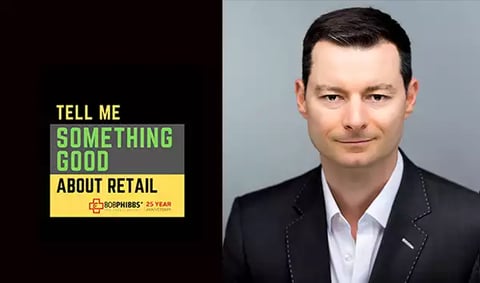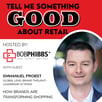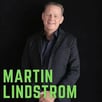Retail Podcast 313: Dr. Emmanuel Probst on How to Succeed in a Saturated Market

Bob Phibbs interviewed Dr. Emmanuel Probst, author of Brand Hacks: How to Build Brands by Fulfilling the Human Quest for Meaning and Adjunct Professor at UCLA. In this episode Bob and Emmanuel talked about social media influencers cheating their audiences and how to make it in a saturated market.

Tell me something good about retail
Dr. Emmanuel Probst on How to Succeed in a Saturated Market
Bob: Today's guest is Emmanuel Probst. He teaches consumer market research at UCLA and is the author of the new book, Brand Hacks, which reveals why most ad campaigns fail and how to use brand hacks for your own business. So good morning.
Emmanuel: Good morning, Bob. Thank you for having me on the show.
Bob: Of course. So, who are you and what do you have to do with retail?
Emmanuel: Thank you, Bob. I, I started in retail. That's why it's compelling. When I first arrived in the UK, that was in 2001 I'm dating myself here, but I worked on a shop floor and in very diverse environments. I worked in luxury retail for churches, shoes, which would be Cleveland, and John Allen Edmonds is a type of store you would find on a Madison Avenue.
Bob: I love those shoes. Absolutely.
Emmanuel: They're great shoes and then I worked for phones. And at the time, selling cell phones. So, very fast based retail environment and literally my career. I also work in consumer experience management. Years ago, I helped the likes of buffet and Victoria's secret at the time, and TJ Friday's and Chili's.
Bob: Great. Well you've, you've written a compelling new book, and in it you say that consumers are sick and tired of advertising. So if that's true, then what are successful brands doing instead.
Emmanuel: Yeah, I'm constantly sick and tired of it because we built them out. It's too many messages and we are interrupting their lives and their conversations, and we are dissecting their community.
What brands should do well, what consumers look for. They look for meaning. Then look for something that's purposeful and engaging. And what brands should do is understand that. So instead of pushing more advertising, more marketing bounds with quotas of consumers, take a step back.
Understand what consumers really want to achieve in life. From there, build a brand that's meaningful, that helps fulfill this quest for meaning.
Bob: So, it seems to me, when I look at most retailers these days, the consumer wants a deal. All they care about is whoever is cheapest and, where they can get their loyalty points. Can you describe the difference between a meaning, you know, maybe a trend or something, because you talk about that in the book as well. And I think meaning is so easy to misunderstand.
Emmanuel: Yeah, you're right. I'm happy to. So first you said consumers want a deal and that's tempting for retailers because that drives traffic.
But that doesn't drive the brand in the long run. And we can talk more about this in a second.
You'd send Brooke Coley smoothies for the rest of your life. It's a trend that is something that is likely to influence the market in a five to seven-year window. So what is a trend? Meditation is a trend. cross fit is a trend whereby you have brick and mortar retail businesses being built around those trends.
And hopefully that lasts for a while. The meaning now is something that is deeper, that is more purposeful and fulfilling. That gives you the feeling of doing something that's larger than yourself. So how do you benefit the community? How is that beneficial for your personal identity?
But something that is a lot more engaging and a lot deeper than just the fad diet or the quest for you to workout.
Bob: Gotcha. Well, I know, faith popcorn had talked probably 20 years ago. She saw cocooning was going to be the big trend and that it was going to be a matter of going home and shutting the world out.
And, you know, at the time I thought, "Oh, well, this is going to have legs." Well, we're still seeing it continuing to expand, right? Where grocery stores where restaurants are all fighting over, "how do I get product to the customer so they don't have to leave their home?" And does that look like that adds to somebody meaning that they don't have to do it.
Emmanuel: Yeah, you're right. I think cocooning was a little bit of a buzzword and that world evolved. But meaning is still there. So, I'll give you an example, but people tend to live in smaller homes now, and it's not so much because of Monet, because of affordability is the trend or the big McMansions is.
Because we want something that is more personable. Maybe it was some history. Well, we call it a place where you can sit and you can see the world from th isplace. So in all likelihood in your house, you have maybe a recliner, maybe a particular chair, or maybe a pillow, or place in your house where you like to sit and that - we're going back to cocooning.
That's your place where you like to sit, reflect, and see the world from. And to your point, a meaningful trend, I would say a meaningful trend is very, very preventative for sure. And important for retail.
Bob: Yeah. I live in upstate New York and I look out over the Hudson river.
I consider myself fairly privileged in that respect, that I can go all around the world and speak to audiences of tens of thousands of people, but when I get home, I want to be home. I want to have my little place in the world where, you know, I can be in my place and enjoy kind of tuning out from all of that, even though I'm probably still on my stupid iPhone and fully connected.
You know, in the book you talk about psychographics and micro moments. Can you give me a little bit more on that?
Emmanuel: Yeah. These are very important for retailers and for our audience. Bob, for the longest time we targeted people on demographics, so age, gender, region, household income, size, household, educational background, different backgrounds.
Psychographics, these are about your mindset, your values, your preferences, your attitudes. And my point is, unless you sell the house or maybe a car income types doesn't really matter much. What matters is the mindset of the consumer. So let me explain. If you take a luxury brand like Courage Retone.
Well, it's a handbag that's $4,000. They decide to treat themselves, invest in the bags because of the emotional benefits. The point of psychographics is to say you're going to talk to your consumers based on their mindsets, based on their lifestyle attributes, based on who they are and who they want to become.
That's how Starbucks can charge you $5 for a cup of coffee and sell that to students that make $12,000 bucks a year on campus. It's not because it's affordable, it's because they agreed to Starbucks. You are part of these groups. You are part of this tribe. That's why psychographics are so important.
When I'm at Starbucks, it's not so much about the income and the ethnic background. That's not important. What's important is what are their lifestyle values? That is, who are they and who do they want to become?
Bob: think that's really interesting. You know, there was an article recently about the difference between I think illustrating this point that the Levi's customer is not the Wrangler customer and how they are seeing that Levi's customers are worn in blue States, typically in large urban areas.
Whereas Wrangler is predominantly being seen in red States and more rural areas. And the badge of honor for both is "you know, me and these are my people." And I think in some ways it can sound very simplistic. "Oh, okay. So which brand are you?" But I think we're more complex than that, aren't we?
I mean, aren't we. I hope to goodness that we are not going to become more polarized, but that we find out we're more alike than different. But certainly we do define ourselves by the products that we purchase. More than like when I grew up as a kid, as a boomer, everything was mass market. So everybody would take the one headache pill, or wear the Levi's.
As we seem to see more and more micro brands coming online, it would seem harder in many ways to achieve scale marketing to people based on their lifestyles and aspirations.
Emmanuel: Just like you, at times, I'm baffled to see correlations between brands and politics.
What you said about Levi's versus Wrangler is sort of true. We see this across other products in automotive, for example. So, David Axelrod, who advised Barack Obama back in 2008 from data science, David Axelrad and his team had this idea that should you drive a minivan in Ohio, you are going to vote Republican.
The correlation is like 90% a minivan. It's baffling. Both correlations are very surprising. So my point is, frankly, politics and brands go hand in hand. Because some brands are politically polarized, whether they want you to tell them that I'd run like Nike of course the likes of Fox, CNN, and hotels was, are very, very polarized, but many brands are slightly, at least likely polarized politically.
Also that teaches us that marketing and politics, these are two of the same things because politicians are brands themselves, at least in my experience. And then you spoke about micro brands and scaling those brands. And I think that's what's compelling with the direct to consumer business.
I feel the short answer is micro brands can succeed even in saturated markets because they bring a new experience, not a new product, but a new experience and more importantly a new relationship with the client. And I think that's something. Our audience and retailers should really think very deeply about "what is my relationship with clients?"
"How do I foster a very personal relationship with my customers, and how can they scale?" Well, that's the beauty of data and technology because you can ship your goods for cheap around the country because you can manage your supply chain so that you can scale fairly reasonably easily, if you will.
Bob: Well, and you're not trying to be a mass merchant. So, you know, you look at the rise of a brand, for example, like a Casper, and you can understand that they know who their brand is, but I think of Casper though. I'm an old guy. I'm a boomer. I'm 61, you know, to me, Casper is a millennial brand because I never would take a video of my mattress resting cause you have to let it rest before you lay on it. Taking videos and sharing that on social media. But if you know who that person is, I think there are so many more ways now that you can, to your point, you know, hack that moment to say that I know exactly who my customer is and you go to market knowing that before saying, I'll just build it and see who comes. I think those days are probably gone.
Emmanuel: I could not agree more. And Casper's a perfect example of that new edition I was referring to. So, here's the deal. The very last thing we needed in United States is another non-trusted retailer. We already have thousands and thousands of stores selling mattresses.
So that's exactly what I meant when I said micro brands can enter a saturated, lean market and transform these markets. What did Tesco do? Do they sell mattresses? Yeah, sure of course they do. More importantly, they established a new relationship with the customer. They established a new sales channel to sell the same very lame product but engaged in a very different relationship and very different format with the consumer, and they're telling your story, and that is so important.
Casper in Soho, New York opened the Dreamery and the Dreamery is a place where you can go to take a nap for 30 minutes and they provide you with a shed and relaxing place and all that stuff. What's important is Casper is telling you a story about sleep, about reflecting, about taking time for yourself.
And I stress from an example, American Metro. They're pushing some “come to my store this weekend, 20% on everything.” That's a lower funnel drive too. Short sighted, short term strategy.
Bob: Well and does it? It doesn't seem like that is working.
It’s interesting to me that a couple of years ago, Target went through and announced they were going to put all this money into their stores and their people. Walmart does the same thing, opens 200 training centers and the stock tanks. People say, “why are you investing in brick and mortar stores?”
And yet both of them have come through in the last season and have been darlings because they have been able to figure it out. I think target certainly has become the millennial department store. I think people understand them. They get the value proposition. I think they feel smarter going there.
And yet a lot of legacy brands, like Macy's - most department stores are still struggling with this. So, what kind of brand hacks do you think that some of these legacy retailers could adopt to survive.
Emmanuel: very interesting. What you said about target and the bright spot for our audience today is I feel today’s retail is very relevant.
I don't think retail is going away. And to address your question about Macy’s, the store format I think doesn't work because the store is too small to compete with Amazon on inventory. And it's too big too.
Target developed a lot of private labels, a lot of their own brands, and we don't see much of the at Macey’s. Nobody can win against Amazon on price and convenience and on inventory. To address your question precisely, I think there's a lot of potential in retail for smaller footprints, smaller store footprints for those personal experience.
There’s an opportunity in retail for an online to offline, to online experience. So someone that does this, for example, whereby you can go on the website, buy some products, but you'd go in store because you want some tips on how to use their products and maybe you'll see more products.
And then you keep you your journey if you will. You continue with your journey online, but with a smaller store format for sure. In a nutshell, the opportunity for retail is to deliver an experience and some emotions that you cannot experience online because Amazon does not convey emotions.
Amazon conveys convenience, price, inventory, and reliability.
Bob: So, you have harsh words for so-called social media influencers. I mean, is that because you're jealous of their fame and money or, and no one's asking you, or do you think that there's something kind of backwards about them, especially when it comes to marketing your brand?
Emmanuel: that's a good point.
I don't think I would be so talented at doing silly things on YouTube. So, from death, fame, and money. Yeah, it's quite impressive to see how much wealth they amassed in short. I have harsh words for these influencers because I don't think they’re genuine and authentic anymore as they were meant to be in the first place, at least not most of them. Social influencers build their audience and their business on the fact that we can relate to them, or if anything, millennials and gen Z can relate to them.
It's kind of that the girl next door, if you will, type of relationship in academia. We call this reducing this social distance. So, in contrast. When you see George Clooney or bookshelves in an OD or LeBron James or people like this, while you may hire them, I think it's hard to relate because you don't really live their lives.
They don't live in your neighborhood. They drive faster cars and have a nicer house than you do. They're not relatable. And not accessible. In contrast, social influencers are supposed to be relatable and accessible all the time. As they became wealthier with larger audiences, they are just cheating their audience into making them believe that they are skilled, relatable, accessible.
Bob: I think people see through that.
I know I, as you were saying that I was remembering a bit by Lily Tomlin and, the interviewer asks her, “Lily you've been accused of selling out,” and she answers, “well, I've always been selling out. It's just before there were no buyers.” And I think that's kind of what social media influencers are like.
Yeah, they would have taken a check much earlier, just nobody was offering it to them. So, that's a great point and we're getting close to the end of our time. I'm curious, how has the way you thought about retail changed from when you worked on the floor, you know, decades ago to what you're seeing happening now?
Emmanuel: I'm keen to tell you about what has changed and what has not changed so. What are has changed that goes without saying is people don't need to leave their home anymore. We need to give them a much stronger reason to come to the store. How do we do this? With a very unique experience. We show something unique in the store.
Maybe it's artwork, maybe it can be a DJ on Friday. Maybe we can do a popup store. Something that is very eventful. Maybe we can bring a guest designer or guest speaker. But we need to create an uneven timber store so that yours still becomes a go to in the community. We cannot just sell goods and services in stores.
That just doesn't work anymore. That has changed. Reflecting all the way to 2001 when I was selling shoes at churches is. It was the importance of this personal relationship with clients and this attention to detail and this empathic, genuine connection with the customer.
Bob: I couldn't say that better. That's the world I work in my friend. So, how can they find out more about you and your new book?
Emmanuel: Thank you, Bob. My profile on LinkedIn is Emmanuel and the book is, Brand Hacks: How to build brands by fulfilling the human quest for meaning available on Amazon, of course. And I also work as the senior vice president of brand health tracking for each source.
Bob: Excellent. Well, thank you again for joining me today.
Emmanuel: Thank you, Bob.

Find out more about Emmanuel

Take My FREE Retail Assessment Quiz
Use this free Retail Assessment Tool to discover where you truly excel in retail, and uncover areas for improvement.


